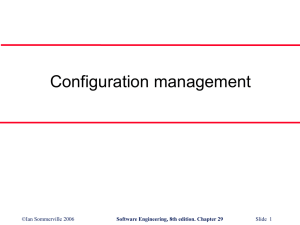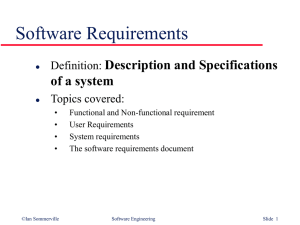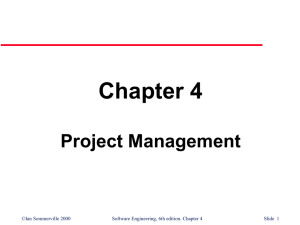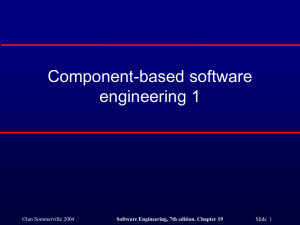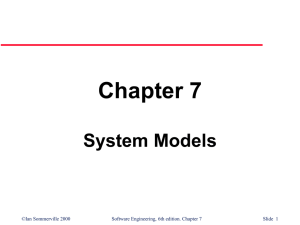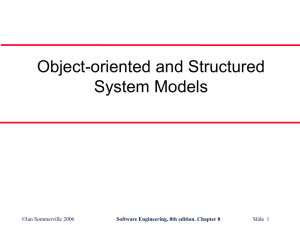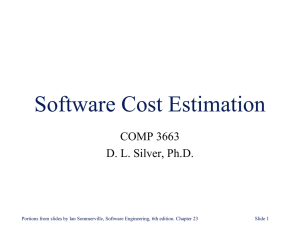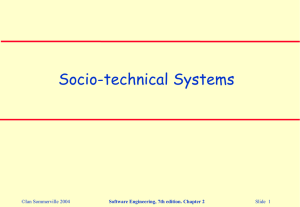Requirements Engineering Processes
advertisement
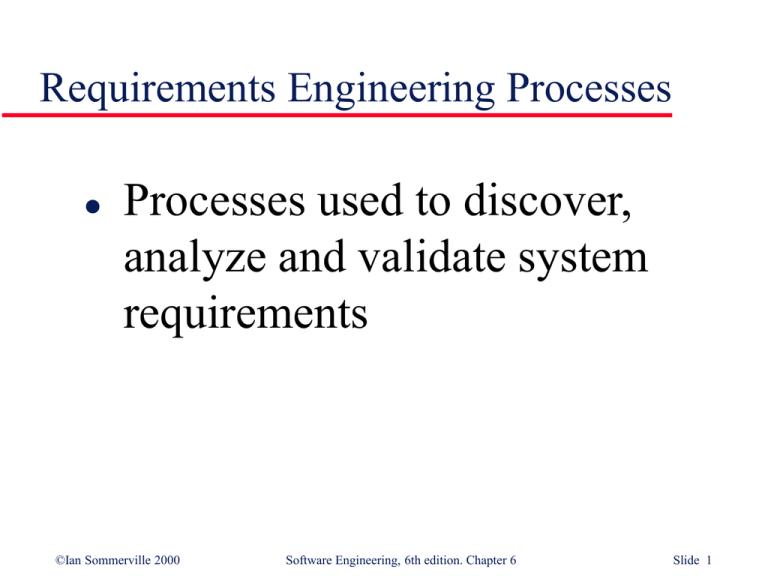
Requirements Engineering Processes Processes used to discover, analyze and validate system requirements ©Ian Sommerville 2000 Software Engineering, 6th edition. Chapter 6 Slide 1 Requirements engineering processes The processes used for RE vary widely There are a number of generic activities common to all processes • • • • Requirements elicitation Requirements analysis Requirements validation Requirements management ©Ian Sommerville 2000 Software Engineering, 6th edition. Chapter 6 Slide 2 Elicitation and analysis Involves technical staff working with customers to find out about: • • • The application domain, The services that the system should provide and The system’s operational constraints May involve end-users, managers, engineers involved in maintenance, domain experts, trade unions, etc. • • These are called stakeholders Hospital Example ©Ian Sommerville 2000 Software Engineering, 6th edition. Chapter 6 Slide 3 Problems of requirements analysis Stakeholders • • • Don’t know what they really want Express requirements in their own terms Different stakeholders may have conflicting requirements Organizational and political factors influence requirements Requirements change during the analysis process. New stakeholders may emerge ©Ian Sommerville 2000 Software Engineering, 6th edition. Chapter 6 Slide 4 Viewpoint-oriented elicitation Stakeholders represent different ways of looking at a problem or problem viewpoints This multi-perspective analysis is important as there is no single correct way to analyse system requirements ©Ian Sommerville 2000 Software Engineering, 6th edition. Chapter 6 Slide 5 Banking ATM system (simplified) Offers services to customers of the bank, owns the system, and other customers Services include • • • • cash withdrawal, message passing (send a message to request a service), ordering a statement and transferring funds ©Ian Sommerville 2000 Software Engineering, 6th edition. Chapter 6 Slide 6 ATM viewpoints Bank customers Representatives of other banks Hardware and software maintenance engineers Marketing department Bank managers and counter staff Database administrators and security staff Communications engineers Personnel department ©Ian Sommerville 2000 Software Engineering, 6th edition. Chapter 6 Slide 7 Types of viewpoint Data sources or sinks • Representation frameworks • Viewpoints are responsible for producing or consuming data. Viewpoints represent particular types of system model such as real-time systems. Receivers of services • Viewpoints are external to the system and receive services from it. ©Ian Sommerville 2000 Software Engineering, 6th edition. Chapter 6 Slide 8 Method-based analysis Widely used approach to requirements analysis. Depends on the application of a structured method to understand the system A viewpoint-oriented method (VORD) is used as an example here. It also illustrates the use of viewpoints ©Ian Sommerville 2000 Software Engineering, 6th edition. Chapter 6 Slide 9 The VORD method Viewpoint identification ©Ian Sommerville 2000 Viewpoint structuring Viewpoint documenta tion Software Engineering, 6th edition. Chapter 6 Viewpoint system ma pping Slide 10 VORD process model Viewpoint identification • Viewpoint structuring • Group related viewpoints into a hierarchy. Common services are provided at higher-levels in the hierarchy Viewpoint documentation • Discover viewpoints which receive system services and identify the services provided to each viewpoint Refine the description of the identified viewpoints and services Viewpoint-system mapping • Transform the analysis to an object-oriented design ©Ian Sommerville 2000 Software Engineering, 6th edition. Chapter 6 Slide 11 VORD standard forms Vie wpoint te mplate Ref er ence : The viewpoint na m e. Att ribut es: Attr ibute s providing viewpoint inf or m ation. Eve nt s: A re fe re nc e to a se t ofe ve nt sc ena rios de scr ibing how the sy stem r ea c ts to viewpoint events. Ser vic es A re fe re nc e to a se t of se rvic e de sc riptions. Sub-VPs: The nam e s of subviewpoints. ©Ian Sommerville 2000 Ser vic e te mplate Ref er ence : The se rvic e na m e. Rat ionale: Rea son why the se rvic e is provided. Spe cif ic at ion: Ref er ence to alist of se rvice spec if ica tions. These m ay be e xpre sse d in diffe re nt nota tions. Vie wpoint s: List of vie wpoint na m es re ce iving the se rvic e. Non-f unct ional Ref er ence to a se t of non r equir eme nt s: func tional re quir em e nts which constr ain the se rvic e. Provide r: Ref er ence to alist of sy ste m obje c ts which pr ovide the se rvic e. Software Engineering, 6th edition. Chapter 6 Slide 12 Viewpoint identification Query balance Get transactions Customer database Card returning Manager Machine supplies Message log Account information User interface Account holder Remote diagnostics ©Ian Sommerville 2000 System cost Stolen card Reliability Cash withdrawal Foreign customer Order statement Update account Transaction log Remote software upgrade Software size Printe r Hardware maintenance Funds transfer Software Engineering, 6th edition. Chapter 6 Order cheques Bank teller Invalid user Security Message passing Card retention Card validation Slide 13 Viewpoint service information ACCOUNT HOLDER Service list Withdraw cash Query balance Or der cheques Send message Transaction list Or der statement Transfer funds ©Ian Sommerville 2000 FOREIGN CUSTOMER Service list Withdraw cash Query balance Software Engineering, 6th edition. Chapter 6 BANK TELLER Service list Run diagnostics Add cash Add paper Send message Slide 14 Viewpoint data/control ACCOUNT HOLDER Control input Start transaction Cancel transaction End transaction Select service ©Ian Sommerville 2000 Da ta input Card details PIN Am ount required Message Software Engineering, 6th edition. Chapter 6 Slide 15 Viewpoint hierarchy All VPs Services Query balance Withdraw cash Services Customer Account holder Foreign customer Bank staff Teller Manager Engineer Order cheques Send message Transaction list Order statement Transfer funds ©Ian Sommerville 2000 Software Engineering, 6th edition. Chapter 6 Slide 16 Customer/cash withdrawal templates Reference: Customer Reference: Cash withdrawal Attributes: Account number PIN Start transaction Events: Select service Cancel transaction End transaction Rationale: To improve customer service and reduce paperwork Services: Cash withdrawal Balance enquiry Specification: Users choose this service by pressing the cash withdrawal button. They then enter the amount required. This is confirmed and, if funds allow, the balance is delivered. VPs: Sub-VPs: Account holder Foreign customer Deliver cash within 1 minute Non-funct. requirements: of amount being confirmed Provider: ©Ian Sommerville 2000 Customer Filled in later Software Engineering, 6th edition. Chapter 6 Slide 17 Scenarios Scenarios are descriptions of how a system is used in practice They are helpful in requirements elicitation as people can relate to these more readily than abstract statement of what they require from a system Scenarios are particularly useful for adding detail to an outline requirements description ©Ian Sommerville 2000 Software Engineering, 6th edition. Chapter 6 Slide 18 Scenario descriptions System state at the beginning of the scenario Normal flow of events in the scenario What can go wrong and how this is handled Other concurrent activities System state on completion of the scenario ©Ian Sommerville 2000 Software Engineering, 6th edition. Chapter 6 Slide 19 Event scenarios Event scenarios may be used to describe how a system responds to the occurrence of some particular event such as ‘start transaction’ VORD includes a diagrammatic convention for event scenarios. • • • • Data provided and delivered Control information Exception processing The next expected event ©Ian Sommerville 2000 Software Engineering, 6th edition. Chapter 6 Slide 20 Event scenario - start transaction Card present Valid card User OK Card Request PIN PIN Timeout Return card Account number PIN Validate user Account number Select service Incorrect PIN Re-enter PIN Invalid card Return card Incorrect PIN Stolen card Return card Retain card ©Ian Sommerville 2000 Software Engineering, 6th edition. Chapter 6 Slide 21 Notation for data and control analysis Ellipses. data provided from or delivered to a viewpoint Control information enters and leaves at the top of each box Data leaves from the right of each box Exceptions are shown at the bottom of each box Name of next event is in box with thick edges ©Ian Sommerville 2000 Software Engineering, 6th edition. Chapter 6 Slide 22 Exception description Most methods do not include facilities for describing exceptions In this example, exceptions are • • • Timeout. Customer fails to enter a PIN within the allowed time limit Invalid card. The card is not recognised and is returned Stolen card. The card has been registered as stolen and is retained by the machine ©Ian Sommerville 2000 Software Engineering, 6th edition. Chapter 6 Slide 23 Use cases Use-cases are a scenario based technique in the UML which identify the actors in an interaction and which describe the interaction itself A set of use cases should describe all possible interactions with the system Sequence diagrams may be used to add detail to use-cases by showing the sequence of event processing in the system ©Ian Sommerville 2000 Software Engineering, 6th edition. Chapter 6 Slide 24 Lending use-case Lending services ©Ian Sommerville 2000 Software Engineering, 6th edition. Chapter 6 Slide 25 Library use-cases Lending services Library User User administration Supplier ©Ian Sommerville 2000 Library Staff Catalog services Software Engineering, 6th edition. Chapter 6 Slide 26 Catalogue management Item: Library Item Books: Catalog Cataloguer: Library Staff Bookshop: Supplier Acquire New Catalog Item Dispose Uncatalog Item ©Ian Sommerville 2000 Software Engineering, 6th edition. Chapter 6 Slide 27 Social and organizational factors Software systems are used in a social and organizational context. This can influence or even dominate system requirements Social and organizational factors are not a single viewpoint but influence all viewpoints Good analysts must be sensitive to these factors but currently no systematic way to tackle their analysis ©Ian Sommerville 2000 Software Engineering, 6th edition. Chapter 6 Slide 28 Example Consider a system which allows senior management to access information without going through middle managers • • • Managerial status. Senior managers may feel that they are too important to use a keyboard. This may limit the type of system interface used Managerial responsibilities. Managers may have no uninterrupted time where they can learn to use the system Organisational resistance. Middle managers who will be made redundant may deliberately provide misleading or incomplete information so that the system will fail ©Ian Sommerville 2000 Software Engineering, 6th edition. Chapter 6 Slide 29 Requirements validation Demonstrating that the requirements define the system that the customer really wants High requirements error costs make validation important Cost of fixing a requirement error: • • • • • • Phase requirements design coding testing operation ©Ian Sommerville 2000 Cost 2 5 15 50 150 Software Engineering, 6th edition. Chapter 6 Slide 30 Requirements checking Validity. Does the system provide the functions which best support the customer’s needs? Consistency. Are there any requirements conflicts? Completeness. Are all functions required by the customer included? Realism. Can the requirements be implemented given available budget and technology Verifiability. Can the requirements be checked? ©Ian Sommerville 2000 Software Engineering, 6th edition. Chapter 6 Slide 31 Requirements validation techniques Requirements reviews • Prototyping • Using an executable model of the system to check requirements. Covered in Chapter 8 Test-case generation • Systematic manual analysis of the requirements Developing tests for requirements to check testability Automated consistency analysis • Checking the consistency of a structured requirements description ©Ian Sommerville 2000 Software Engineering, 6th edition. Chapter 6 Slide 32 Requirements reviews Regular reviews should be held while the requirements definition is being formulated Both client and contractor staff should be involved in reviews Reviews may be formal (with completed documents) or informal. Good communications between developers, customers and users can resolve problems at an early stage ©Ian Sommerville 2000 Software Engineering, 6th edition. Chapter 6 Slide 33 Review checks Verifiability. Is the requirement realistically testable? Comprehensibility. Is the requirement properly understood? Traceability. Is the origin of the requirement clearly stated? Adaptability. Can the requirement be changed without a large impact on other requirements? ©Ian Sommerville 2000 Software Engineering, 6th edition. Chapter 6 Slide 34 Requirements management Requirements management is the process of managing changing requirements during the requirements engineering process and system development Requirements are inevitably incomplete and inconsistent • • New requirements emerge during the process as business needs change and a better understanding of the system is developed Different viewpoints have different requirements and these are often contradictory ©Ian Sommerville 2000 Software Engineering, 6th edition. Chapter 6 Slide 35 Requirements change The priority of requirements from different viewpoints changes during the development process System customers may specify requirements from a business perspective that conflict with end-user requirements The business and technical environment of the system changes during its development ©Ian Sommerville 2000 Software Engineering, 6th edition. Chapter 6 Slide 36 Requirements evolution Initial understanding of problem Changed understanding of problem Initial requirements Changed requir ements Time ©Ian Sommerville 2000 Software Engineering, 6th edition. Chapter 6 Slide 37 Enduring and volatile requirements Enduring requirements. Stable requirements derived from the core activity of the customer organisation. E.g. a hospital will always have doctors, nurses, etc. May be derived from domain models Volatile requirements. Requirements which change during development or when the system is in use. In a hospital, requirements derived from health-care policy ©Ian Sommerville 2000 Software Engineering, 6th edition. Chapter 6 Slide 38 Traceability Traceability is concerned with the relationships between requirements, their sources and the system design Source traceability • Requirements traceability • Links from requirements to stakeholders who proposed these requirements Links between dependent requirements Design traceability • Links from the requirements to the design ©Ian Sommerville 2000 Software Engineering, 6th edition. Chapter 6 Slide 39 A traceability matrix Req. id 1.1 1.2 1.3 2.1 2.2 2.3 3.1 3.2 1.1 1.2 1.3 U R U R ©Ian Sommerville 2000 2.1 2.2 2.3 3.1 R 3.2 U R R R U U U U R R Software Engineering, 6th edition. Chapter 6 Slide 40 SE tool support Requirements storage • Change management • Requirements should be managed in a secure, managed data store The process of change management is a workflow process whose stages can be defined and information flow between these stages partially automated Traceability management • Automated retrieval of the links between requirements ©Ian Sommerville 2000 Software Engineering, 6th edition. Chapter 6 Slide 41 Requirements change management Should apply to all proposed changes to the requirements Principal stages • • • Problem analysis. Discuss requirements problem and propose change Change analysis and costing. Assess effects of change on other requirements Change implementation. Modify requirements document and other documents to reflect change ©Ian Sommerville 2000 Software Engineering, 6th edition. Chapter 6 Slide 42
